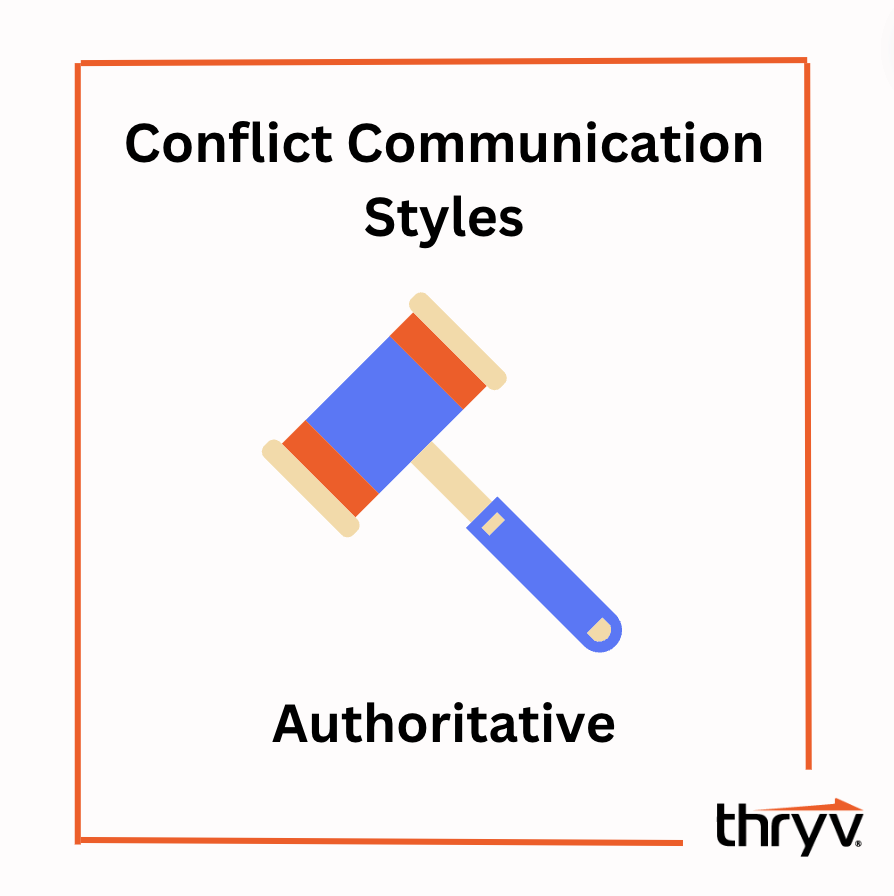Conflicts happen, even if you’re the best manager in the world.
People have different communication styles, and your team doesn’t always work in sync. Even if you’re not disagreeing with your coworkers – you might just communicate differently and can’t get on the same page. If you don’t understand each other’s points, how can you ever come to a resolution?

How-to Guide: 4 Ways to Run an Efficient Small Business
DownloadAs a small business owner, your time is precious. Learning how to navigate conflict communication is important for managing your business. Conflicts not only derail your team, but affect your bottom line.
This post will review everything you need to know about conflict communication, including how your management style affects the outcome of conflicts. We’ll also explain why conflicts happen at work and how to avoid them.
What Is Conflict Communication?
Conflict communication is the process of managing interpersonal issues. It’s what you do to identify a conflict and the steps taken to resolve it.
In a work setting, conflict communication means managing issues between employees or customers. Conflicts between employees can affect your business’s productivity, and conflicts with customers can impact your sales and marketing. Understanding how to navigate both types of conflict will help keep customers happy and your business running smoothly.
What role does communication play in navigating conflict?
Conflicts are uncomfortable, but the only way to solve them is to talk about them.
Talking about a conflict can be awkward, especially when it’s with a coworker — or even worse, a manager. These situations show why it’s important to prepare for conflicts because discussing them isn’t easy.
The good news is that employees want to resolve conflicts. 80% said they’re not afraid to have difficult conversations if it leads to a win-win solution.
Your job as a manager is to figure out how to accommodate different conflict communication styles (including your own) to get that solution.
What Causes Conflicts at Work?
Let’s cover three triggers that cause up to 91% of workplace conflicts.
1. Communication Styles
Sometimes, people don’t vibe with each other. That’s okay, but it’s still important to prevent and resolve conflicts.
If employees have different communication styles, they still need to learn how to work together. As a business owner, you can manage these conflicts by giving employees a way to deal with these issues without your input. For example, you can be proactive and provide clear guidelines for how employees should communicate with each other. If the rules are clear, it creates a common ground for both parties. If all else fails, you can schedule each employee for different shifts, so they keep communication to a minimum.
2. Perceptions of Unfair Treatment
Whether it’s intentional or not, some employees may be unhappy with their jobs. They might want more responsibility in their day-to-day work or are looking to land a promotion. They could think they should have earned that promotion by now and are upset that it hasn’t happened yet.
Employees may also worry that you’re playing favorites and are going too easy on a coworker when they make a mistake. Or, it might be the opposite, and they think you’re harder on one team member than all the rest.
Whatever the cause is, the feeling of being treated unfairly creates a toxic culture that leads to resentment and gossip within your team.
3. Unclear Expectations
Unclear expectations are a common cause of conflict between managers and employees. Both parties feel misunderstood because they both believe they did their job. In reality, each side is looking at the other, scratching their heads and trying to figure out where things went wrong.
Here are some ways to make sure your expectations are clear:
- Share them through multiple communication channels.
- Write them down and make them accessible.
- Keep your list concise.
- Explain how success will be measured.
- Explain the “why” behind each ask.
Now that we’ve gone over the most common conflicts in the workplace, let’s discuss what you can do to improve your conflict communication skills.
Conflict Communication Tips
These tips will help you deal with some of the problems that arise at work.
Address problems promptly.
When a conflict comes up, take steps to address it immediately. Letting it go may feel like the best option at the moment (who wants to have hard conversations during a busy workday?), but it almost always makes the problem worse.
Even if it’s not a major issue, letting employees vent can help them move on and improve their workflow. If it’s something bigger, you’ll know right away and can step in to prevent it from snowballing.
Offer to check in with employees and encourage open and honest dialogue. Employees will be more open with you if you build a strong rapport as a manager. Resources like team meetings and group chat platforms help create this culture.
Pro Tip: An employee may not be ready to discuss a conflict at the same time you are. Remind them that your door is always open, and schedule a meeting to discuss it later, if needed.
Remain open-minded.
Nobody likes to hear they’re doing something wrong. It’s your job to make your small business run at its absolute best, which sometimes means having difficult conversations about performance.
No matter the root of the conflict, listen with an open mind. Becoming defensive or upset doesn’t help solve the problem. It can damage your relationship with employees and lower your ability to resolve future conflicts.
Your employees will mirror your reaction. If you’re open-minded, they will be too. Conflict communication works better when everyone is cool-headed and actively listening to the other parties.
Be mindful of your language/body language.
Speaking of not being defensive – take a minute to evaluate your body language.
When we receive negative feedback, our instincts are to go defensive. We want to protect ourselves, but our instincts aren’t always right.
Eye rolling, crossing your arms, and negative facial expressions are all ways that your body language can convey annoyance or doubt.
When engaged in conflict communication, keep your posture and face open and your body relaxed. Avoid “me vs. you” language because it makes the conversation feel like an argument. Instead, focus on finding a solution. Don’t use accusatory or insulting language. Instead, talk about the problem rather than the person.
Pro Tip: Refresh your knowledge of nonverbal communication cues anytime you have a possible conflict communication coming up.
Listen actively.
Are you listening or waiting for your turn to talk? If it’s the latter, don’t stress — we all do it.
Active listening is key to finding a solution and figuring out the real cause of a problem. Focus carefully on what the employee is telling you, and again, don’t jump to defending yourself or waving away their concerns.
Active listening takes practice. Humans are sometimes self-involved, and we think the best ideas are our own. It helps to take conversations slow. It’s okay to take a few moments to consider your response. It’ll show that you’re taking the conversation seriously.
Set clear boundaries and goals.
This point is crucial because it can resolve current conflicts and prevent future ones. Conflict communication should always have boundaries and goals, so everyone knows how to proceed throughout the conversation. For example, if the issue is personality-related, these boundaries should include respecting each other’s time and creating a plan for respectful communication.
You can also use this opportunity to set clear expectations. Ask your employees what they need from you to have a productive conversation. Then, work together to create a communication plan that works for everyone involved.
Pro Tip: If you’re struggling to manage team communication, this list can help you pick the right communication tools for your small business.
Stay on topic.
It’s easy to go off the rails with conflicts (especially if you didn’t follow tip #1). When you’re engaged in conflict communication, focus on the problem at hand. These conversations should be solution-focused and forward-thinking, so everyone walks away feeling heard, productive, and ready to do their jobs.
Pro Tip: For more tips, try this post that highlights different communication skills and how to improve them.
Now, let’s discuss some different management styles and how they affect your choices regarding conflict communication.
Conflict Communication Styles in Management
The right conflict communication strategy differs from business to business (or person to person), and your management style affects how you resolve interpersonal issues. Let’s review the four communication management styles that you can use to solve conflicts at your business.
Authoritative
Authoritative leaders make their own decisions and give orders. They want changes to go through them and expect their team members to listen to their instructions. Authoritarian leaders delegate more to employees while they control strategy and decision-making.
- Pros: Authoritative leaders increase employee productivity and motivate their teams to do their jobs each day. They’re results-driven, and they’re good at making quick decisions for the business.
- Cons: This style doesn’t always encourage open communication, and it can lead to employees being overworked or stressed out about meeting goals. Authoritative leaders should be mindful of what they’re asking employees to do and how much bandwidth their team has.
Visionary
Visionary leaders promote and support the business mission. They’re typically hands-off with day-to-day work and focus on inspiring employees through their vision of success.
- Pros: This style attracts passionate employees who are motivated to achieve a common goal. When employees care about their company, they’re more productive and stay at the business longer.
- Cons: If there’s a lack of hands-on leadership, communication can break down between employees. It’s hard to reconcile issues if there isn’t a clear place to voice them. As a manager, closely monitor potential conflicts and help employees resolve them before they grow into bigger issues.
Pro Tip: If this is your style, check out these 38 communications quotes to inspire your team.
Democratic
Democratic managers believe everyone should have a say in decisions. While the manager is the final decision maker, teams are encouraged to collaborate and share ideas. This approach makes employees feel more invested, and they learn from each other and share different ideas.
- Pros: A democratic style makes everyone feel heard and respected. When open dialogue is allowed, you find creative solutions that you may not have considered before.
- Cons: When everyone has an opinion, it can lead to conflict and stalling. If this is your style, you can improve productivity by setting clear guidelines for conflict communication.
Supportive
This style revolves around the manager supporting their team throughout the workday. These leaders ask what they can do for employees to make their jobs easier or run more smoothly.
- Pros: This style helps teams grow, learn new skills, and gain confidence as professionals. It also encourages them to work together, resolve their conflicts on their own, and operate independently – which helps free up leaders to work on other tasks.
- Cons: It can slow down productivity if everyone isn’t on the same page or completing their assignments as you need them to. Consider how to communicate proactively to avoid conflicts in this style.
Did any of these speak to you? In some cases, you have to adapt your management style to successfully resolve a conflict. That’s why it’s important to understand each of these approaches and how you can use them to work with different employees.
Managing Conflicts at Your Small Business
Communication matters at every level of a small business, and conflict communication is essential for running a workplace where everything goes smoothly.
Conflict communication is an opportunity to learn and improve. Keep practicing your skills, and remember that how you see and relate to people will define your experience, your employees’ productivity, and your business’s success.








